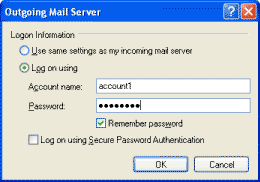Confirming Necessary Information for Scan to E-Mail
note:
This function is available for the D1180/D1170.
You may set the e-mail account you are currently using to this machine if you intend to use this machine only for sending a document scanned using the scan to e-mail functions in this machine.
In such case, the following information is required:
| SMTP server address: |
This is the server address to send an e-mail. |
| Authentication method: |
The following two authentication methods are supported.
(The authentication may not be required depending on the internet provider.)
SMTP authentication
This is the authentication method in which the SMTP server checks the user name and password before sending e-mails.
POP before SMTP
This is the authentication method in which the POP server checks the POP address and POP password before sending e-mails. If your provider uses this method, you need to make settings to send e-mails in this machine.
|
Preparing to Receive I-Faxes
If the provider uses POP before SMTP as the authentication method to send e-mails or if you want this machine to receive I-faxes, you need another POP 3 e-mail account for this machine in addition to the e-mail account you are currently using. For details on the issue of another e-mail account, please consult with your internet provider or network administrator. To make settings, the following information is required.
note:
Please note that this machine can only receive I-fax images and plain text e-mails only.
| POP server: |
The server address that is used when receiving e-mails. In some cases, the address is same as the SMTP server address. |
| POP address: |
This is sometimes called as a mail account or mail ID. |
| POP password: |
The password that is required to receive e-mails. |
Checking Your E-mail Account
If you want to set the e-mail account you are currently using to this machine, you need information required for the setting on your e-mail software in use. Taking Outlook Express 6.x (the e-mail software included with Windows XP) as an example, this section describes the procedures to check your e-mail account.
note:
For Windows Mail (the e-mail software included with Windows Vista), you can check your e-mail account in the same way as for Outlook Express 6.x.
 For Outlook Express 6.x:
For Outlook Express 6.x:
1. Start Outlook Express 6.x.
2. On the [Tools] menu, select [Account] to open the [Internet Account] dialog box.
3. Click the [Mail] tab.

4. Select the account in use, then click [Properties] to open the [<Account name> Properties] dialog box.
5. Click the [Servers] tab.
- If you want to confirm the necessary Information for sending e-mails
Confirm the SMTP server address in [Outgoing mail (SMTP)].
note:
- If there is no need for authentication, skip to Step 9.
- If your provider uses the POP before SMTP authentication method, you need information required for settings to receive e-mails and I-faxes.
- If SMTP authentication is used, go to the next step.
- If you want to confirm the necessary Information for receiving e-mails and I-faxes
Confirm the POP server address in [Incoming mail (POP3)], POP account in [Account name], and POP password in [Password]. Skip to Step 9.
6. Click [Settings] under [Outgoing Mail Server] to open the [Outgoing Mail Server] dialog box.
7. Confirm [Account name] (user name authorized by SMTP server).

note:
The typed password is hidden with "***". Therefore, use a notification form delivered from your provider to check the password.
8. Once you complete confirmation, click [Cancel] to close the [Outgoing Mail Server] dialog box.
9. Click [Cancel] to close the [<Account name> Properties] dialog box.
10. Click [Close] to close the [Internet Account] dialog box.